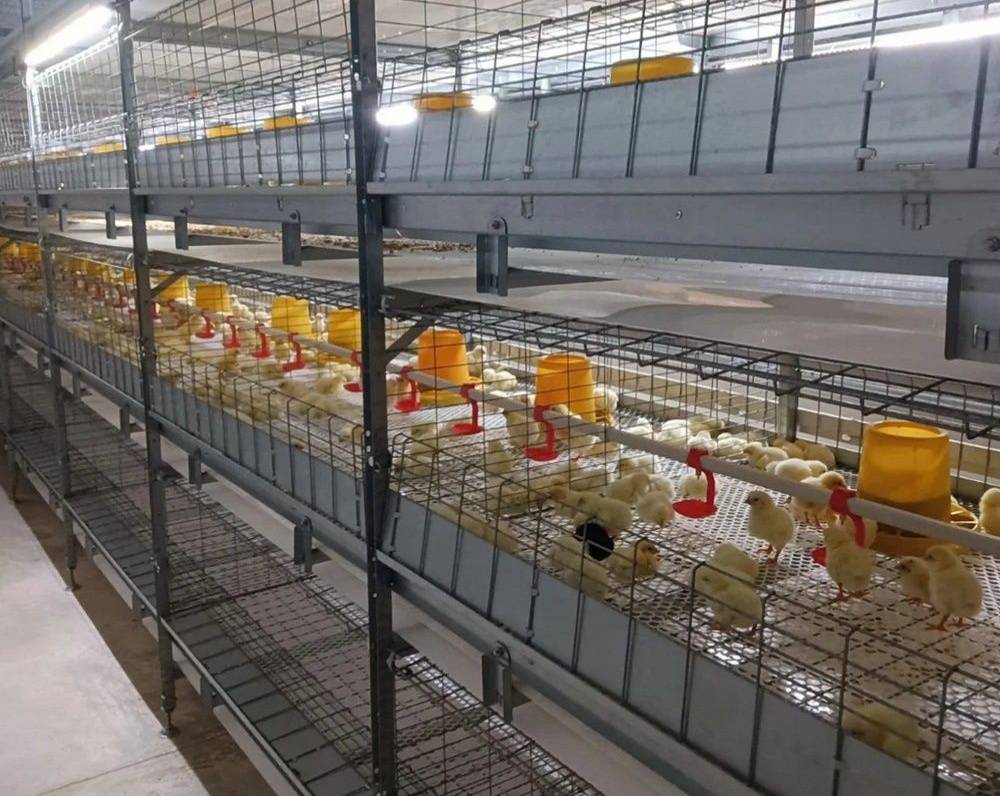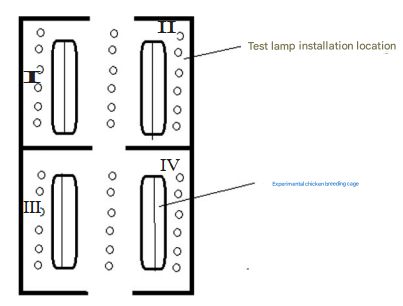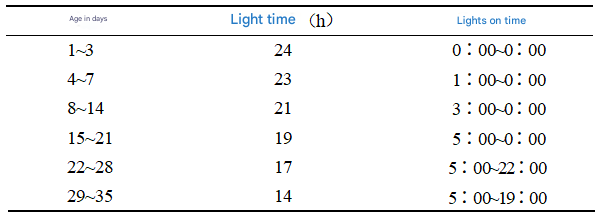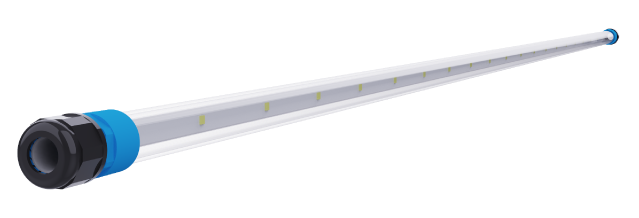Broiler Lighting: Best Light for Chicken Brooder

Directory:
1. Materials and Methods
2. Results
3. Discussion
4. Conclusion
5. best light for chicken brooder
Incandescent lamps have traditionally been the primary lighting choice for high-quality broiler brooding. However, due to their high wattage, short lifespan, and significant energy consumption, they no longer align with the goals of sustainable and energy-efficient animal husbandry. As energy-saving lamps have evolved, various alternatives to incandescent lamps have become available.
The energy-saving lamps commonly used in everyday life fall into two categories: fluorescent energy-saving lamps and LED energy-saving lamps. Fluorescent lamps contain harmful substances and contribute to environmental pollution, while LED lamps are a safer, non-toxic upgrade with a longer lifespan. To identify lighting solutions that better meet the production requirements for high-quality broiler brooding, while also reducing costs and energy use, the author opted to use LED energy-saving lamps for optimizing the broiler lighting setup.
1. Materials and Methods
1.1 Experimental Location
The study was conducted at a broiler breeding farm in a single experimental brooding house featuring a 5 cm color steel sandwich foam board ceiling, heated by an air energy heat pump water circulation system. The ceiling height is 2.6 m, with brick walls on two sides. The brooding house is divided into two identical rooms by a brick wall, with each room containing two independent groups of brooding cages, arranged in three tiers: upper, middle, and lower. The entire brooding house is enclosed.
1.2 Experimental Materials
The experiment involved 699 grandparent chicks sourced from a broiler breeding farm.
1.3 Experimental Methods
A total of 4000 Daheng 699 grandparent chicks that met breeding standards were selected and divided into four large groups, labeled I, II, III, and IV, with each group consisting of 1000 chicks. These groups were raised in separate experimental cage setups within the two brooding rooms. Aside from the differing broiler lighting fixtures, all feeding and management conditions were kept consistent. To prevent light interference between groups, the experimental chicks were only housed on the side of the cages adjacent to the wall, with no chickens or lamps on the side facing the central aisle. Each test group was equipped with six lamps, positioned at the same height and distance from each other (refer to Figure 1), and all windows in the test house were covered. The light sources used were: Group I with 25 W incandescent lamps providing warm yellow light; Group II with 5 W LED lamps offering warm yellow light; Group III with 7 W LED lamps also providing warm yellow light; and Group IV with 9 W LED lamps, again with warm yellow light.
fig1 Lighting fixture installation and test cage location

The experiment was conducted over a period of 30 days, with the lighting changes being completely automated by the system. Table 1 displays the broiler lighting needs for the brooding phase.
table1 Experimental brooding light time requirements

1.4 Index Determination and Methodology
In the course of the experiment, 10% of the chickens from each experimental group were weighed weekly to determine the average weight, with all weighings conducted at 9:00 AM on the same day. At the conclusion of the experiment, comparisons and analyses were made regarding the live weight, uniformity, mortality rate, and economic benefits of each group of brooding chickens.
The light levels for each group were assessed using an illuminometer, with measurement points categorized into upper, middle, and lower sections. The upper point was defined as the intersection of the upper chicken cage trough and the vertical plane of each lamp, the middle point as the intersection of the middle chicken cage trough and the vertical plane of each lamp, and the lower point as the intersection of the lower chicken cage trough and the vertical plane of each lamp (refer to Figure 2). Measurements were taken at 8:00 AM, 12:00 PM, 4:00 PM, and 8:00 PM, with each time slot and measurement point assessed three times. The average of the daily measurement results was used as the data for experimental comparison.
fig2 Measuring point diagram

1.5 Statistics and Analysis
The data were analyzed using EXCEL, and a single-factor T test was conducted on the production performance data of each group using SPSS 10.0 to assess the significance of the differences.
2. Results
2.1 Light Intensity Comparison
Table 2 shows that the light intensity varies among different lamps and wattages at the same measurement point. The incandescent lamp and the 5 W LED lamp exhibit similar light intensity, while the 9 W LED lamp produces the highest intensity. The variation in light intensity corresponds with the changes in the wattage of the LED lamps.
table2 Comparison of light intensity in different experimental groups

2.2 Evaluation of Production Performance
Table 3 presents the weight data for each group. From the information in Table 3. it is evident that the varying light intensities from different lamps and wattages have minimal impact on the weight of chicks across all groups and age categories throughout the trial period, with no significant differences observed between the groups (P>0.05).
table3 Average body weight of each group during the trial period

Table 4 presents a comparison of the production performance across different groups. According to the data in Table 4. there are no notable differences in weight, uniformity, and survival rate among the groups at 30 days of age when various lamps and wattages are utilized for broiler brooding lighting (P>0.05).
table4 Production performance statistics

2.3 Cost Comparison of Usage
2.3.1 Calculation of Broiler Lighting Expenses for Various Lamps
The impact of 5W LED lamps on production performance is comparable to that of 7W and 9W LED lamps, but the energy consumption and cost of the 7W and 9W options are higher than those of the 5W. Consequently, 5W LED lamps are chosen to replace 25W incandescent lamps for the cost analysis. The parameters for calculating costs under different lighting conditions are presented in Table 5. In the brooding house of the test field company, there are 48 lamps per house in a 3-story brooding chicken house, totaling 144 lamps across three buildings. If all incandescent lamps in the chicken house are replaced with 5W LED lamps, 144 LED lamps will be needed. The electricity cost is based on agricultural rates at 0.6 yuan/kWh, and the lighting duration is determined by the requirements of the lighting management system during the brooding period, with three batches of chicks raised each year.
table5 Cost calculation parameter table under the same lighting conditions

2.3.2 Calculation of Related Costs
(1) Energy Usage
Table 6 compares the energy consumption of incandescent bulbs with that of 5 W LED bulbs in real production scenarios.
table 6 Power consumption and total electricity bill

According to Table 6. the monthly electricity expense for LED lamps is 3.063.74 yuan lower than that for incandescent lamps, and the monthly electricity cost for incandescent lamps is five times greater than that for 5 W LED lamps.
(2) Overall cost comparison
The primary expenses for annual usage include the cost of the lamps and the electricity costs. The overall cost comparison is presented in Table 7.
table7 Comprehensive cost calculation table

According to Table 7. incandescent lamps are approximately 3.43 times more expensive than LED lamps, and the annual electricity cost for LED lamps is 3.435.26 yuan less than that of incandescent lamps.
3. Discussion
3.1 Production Performance
There is no notable difference in brooding production performance among the various broiler lighting lamp groups, as the color temperature of the LED lamps is similar to that of incandescent lamps. In terms of light intensity, the 5 W LED lamp is comparable to the 25 W incandescent lamp at different heights, while the 7 W and 9 W LED lamps provide greater intensity than the 25 W incandescent lamp, although none exceed the required brooding light intensity. Previous studies have also indicated that light intensity does not significantly impact brooding outcomes. LED lamps offer the flexibility to adjust light intensity and duration based on the chickens' growth and production needs, whereas incandescent lamps have fixed light intensity. Adjustments to incandescent lighting require changing bulbs, which increases labor demands and can stress the chickens. Additionally, the abrupt switching of artificial lights daily can also be stressful for the chickens. In contrast, LED lamps can be programmed to gradually brighten and dim, mimicking natural light and allowing chickens to adapt, thereby reducing stress.
3.2 Cost
LED lamps consume over 80% less energy than incandescent lamps of the same wattage and have an average lifespan that is more than 20 times longer, without emitting heat. In less strict scenarios, a 5 W LED lamp can be considered equivalent to a 25 W incandescent lamp, a 7 W LED lamp is roughly equal to a 40 W incandescent lamp, and a 9 W LED lamp is comparable to a 60 W incandescent lamp.
Based on comprehensive data regarding the number of lamps used in brooding, the number of batches, and lighting duration, although the initial cost of LED lamps is 5 to 7 times higher than that of incandescent lamps, they offer longer service life and lower energy consumption, resulting in a lower overall brooding cost while achieving the same production results.
4. Conclusion
Switching from 25 W incandescent lamps to 5 W LED lamps for broiler brooding lighting does not negatively impact production performance. The 5 W LED lamps provide longer lifespans, reduced energy consumption, and lower maintenance costs. This transition not only decreases breeding costs but also lessens the environmental impact of poultry farming.
5. best light for chicken brooder
chicken brooder light T5
T5 LED Poultry Lighting System provides solution for chickens to increase egg output, lower mortality, longer peak production period and improve animal welfare. By using intelligent poultry LED lighting system for raising chickens, it is beneficial for higher quantity and quality of eggs, maturity at a faster rate and higher standard of health, compared with way of chicken raised under traditional light sources.
